Fine Ebonized George II Eight Day Table Clock with Dutch Striking and Trip Rep
£14,900
Request Information
Follow Us
Fine Ebonized George II Eight Day Table Clock with Dutch Striking and Trip Rep
By the highly regarded maker Andrew Prime.
Andrew Prime, was apprenticed in 1725 and a member of the Clockmakers’ Company in 1736.
The movement is an extremely accomplished piece of engineering with five knopped pillars, double fusee, on original verge escapement with short knife-edge suspended pendulum. It has Dutch rack striking indicating the hours fully on a larger bell and the half hours also fully (the number of strokes being equal to the number of the following hour) on a smaller bell. In addition, it has trip repeat. The profusely engraved backplate and verge cock apron depict floral and scrolling leaf and vine patterns around a prominent signature cartouche: Andr Prime LONDON.
The break-arch brass dial has a silvered chapter ring, a signature plaque to the arch, date aperture above the VI, and a false pendulum aperture under the XII. The chapter ring has Roman numerals within a minute ring and outer Arabic five-minute track. The dial centre is well matted and the corner spandrels are of the head and scroll design. The time is indicated by a fine pair of pierced blued steel hands.
The ebonized fruitwood veneered oak case has an inverted bell top surmounted by a brass swinging carrying handle, well-formed and returned top moulding and door edge moulding, convex lambs-ear vertical door corners to all sides, circular-over-rectangular side glazed apertures, fretted front door quadrants backed with red silk, and well-formed elaborated concave mouldings.
The clock case is in excellent original condition and the movement has been totally overhauled.
Condition
Good
Dimensions
H 20.87 in. x W 11.82 in. x D 7.09 in.
H 53 cm x W 30 cm x D 18 cm
PREVIOUSLY SOLD
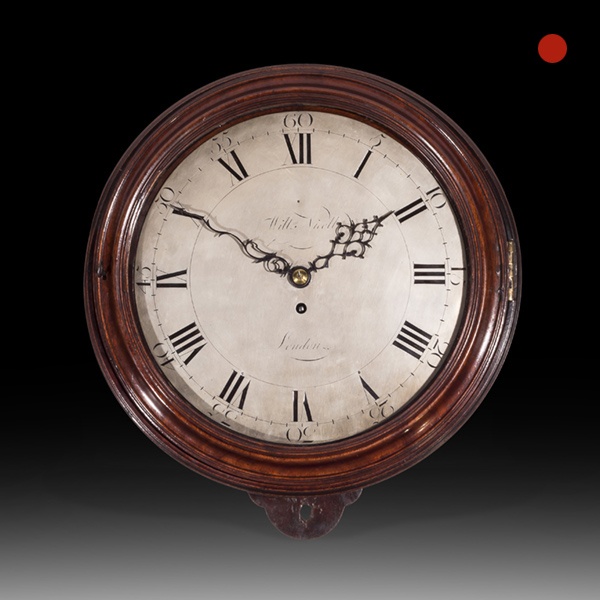
Large Mahogany 18th-Century Dial Clock, William Nicoll, London
The solid mahogany case has a moulded mahogany glazed door, which can be locked on the left-hand side. The original rectangular saltbox is permanently attached to the front and has doors to the side and the bottom.

19th-Century Quarter-striking Carriage Clock by Leroy, Paris
The gilt-brass, so-called corniche case has bevelled glass panels on all sides so that the movement is entirely visible. It is surmounted by a shaped carrying handle. The white enamel dial has a Roman chapter ring, with Arabic five-minute and minute divisions.
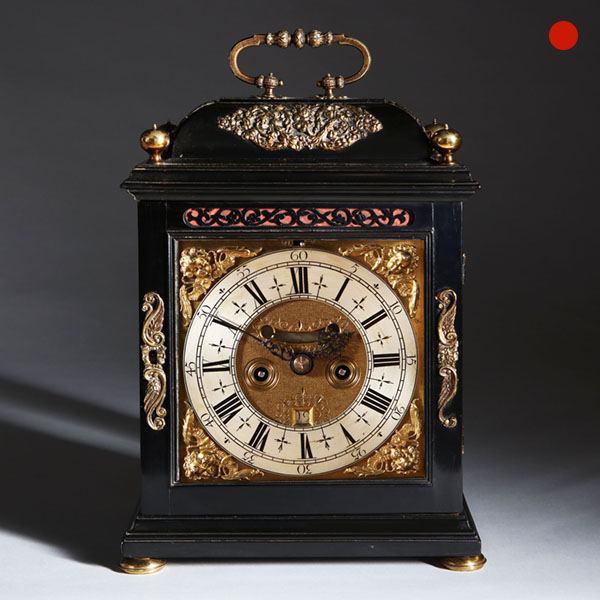
William and Mary Ebony Veneered Bracket Clock by Johnathan Lowndes
The ebony-veneered case has a so-called domed top, a design which became popular in the Charles II period (from 1675 onwards). The case is adorned with repousse brass ornaments and rests on gilt-brass bun feet. It is surmounted by a brass carrying handle of typical shape.
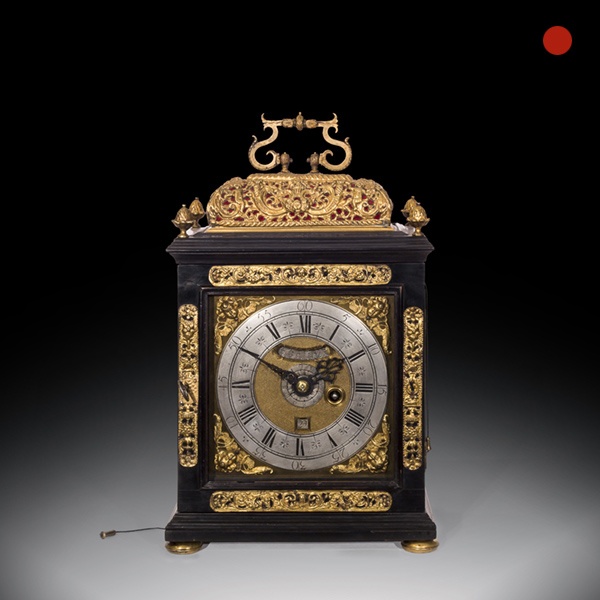
17th-Century Ebony Veneered Table Clock with Alarm and Pull Quarter Repeat
A magnificent sprung driven table clock by respected London maker George Etherington. The late 17th century, ebony- veneered table clock with alarm and pull quarter repeat on two bells, signed on the chapter ring Etherington London, and on the backplate Geo Etherington LONDON, c. 1695-1700.

19th-Century Carriage Clock signed Charles Frodsham, London
The so-called gorge case has its original gilding. It has bevelled glass panels on all sides so that the movement is entirely visible and is surmounted by a shaped carrying handle. The white enamel dial has a Roman chapter ring, with Arabic five-minute and minute divisions.

Large Mahogany 18th-Century Dial Clock, William Nicoll, London
The solid mahogany case has a moulded mahogany glazed door, which can be locked on the left-hand side. The original rectangular saltbox is permanently attached to the front and has doors to the side and the bottom.

19th-Century Quarter-striking Carriage Clock by Leroy, Paris
The gilt-brass, so-called corniche case has bevelled glass panels on all sides so that the movement is entirely visible. It is surmounted by a shaped carrying handle. The white enamel dial has a Roman chapter ring, with Arabic five-minute and minute divisions.

William and Mary Ebony Veneered Bracket Clock by Johnathan Lowndes
The ebony-veneered case has a so-called domed top, a design which became popular in the Charles II period (from 1675 onwards). The case is adorned with repousse brass ornaments and rests on gilt-brass bun feet. It is surmounted by a brass carrying handle of typical shape.

17th-Century Ebony Veneered Table Clock with Alarm and Pull Quarter Repeat
A magnificent sprung driven table clock by respected London maker George Etherington. The late 17th century, ebony- veneered table clock with alarm and pull quarter repeat on two bells, signed on the chapter ring Etherington London, and on the backplate Geo Etherington LONDON, c. 1695-1700.

19th-Century Carriage Clock signed Charles Frodsham, London
The so-called gorge case has its original gilding. It has bevelled glass panels on all sides so that the movement is entirely visible and is surmounted by a shaped carrying handle. The white enamel dial has a Roman chapter ring, with Arabic five-minute and minute divisions.
YOU MAY ALSO LIKE

A Fine 18th Century George II Figured Walnut Chest on Chest or Tallboy, 1740
A Fine 18th Century George II Figured Walnut Chest on Chest or Tallboy, 1740 £14,000[wpforms_selector form_id="11387" _builder_version="4.22.1" _module_preset="default" custom_margin="-30px||||false|false" hover_enabled="0"...

Charles II Olive Oyster Floral Marquetry Table
Attributed to GERRIT JENSEN (worked c.1680-1715) Charles II Olive Oyster Floral Marquetry Table 1680 to 1683 England Sold[wpforms_selector form_id="11387" show_title="on" _builder_version="4.22.1" _module_preset="default"...

A Fine William and Mary 17th Century Figured Walnut Cushion Mirror C, 1690
A Fine William and Mary 17th Century Figured Walnut Cushion Mirror C, 1690 £6,500Follow UsA Fine William and Mary 17th Century Figured Walnut Cushion Mirror C, 1690 A large William and Mary 17th century figured walnut cushion mirror, circa...
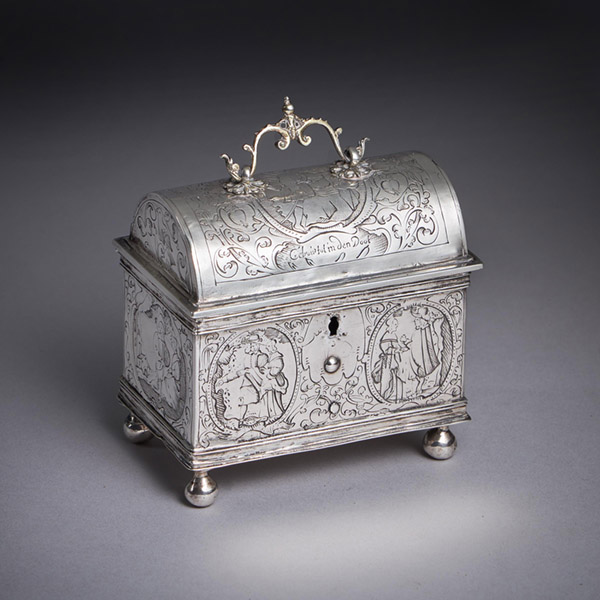
A museum-grade mid-17th century Dutch silver marriage casket or knottekistje, circa 1660
A museum-grade mid-17th century Dutch silver marriage casket or knottekistje, circa 1660 £9,500 [wpforms_selector form_id="11387" show_title="on" _builder_version="4.22.1" _module_preset="default" custom_margin="-30px||||false|false"...

19th-Century French Flame Mahogany Napoleon Empire Period Mantel Clock
19th-Century French Flame Mahogany Napoleon Empire Period Mantel Clock £6,800 [wpforms_selector form_id="11387" show_title="on" _builder_version="4.22.1" _module_preset="default" custom_margin="-30px||||false|false" global_colors_info="{}"...
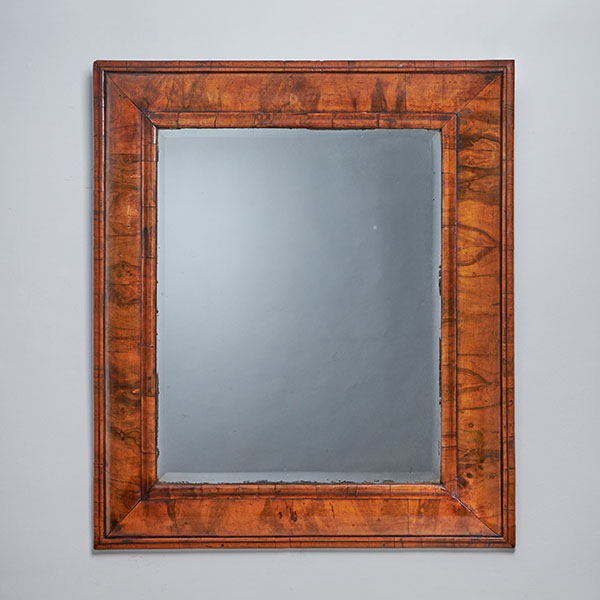
Large William and Mary 17th Century Figured Walnut Cushion Mirror c, 1690
Large William and Mary 17th Century Figured Walnut Cushion Mirror c, 1690 £7,495[wpforms_selector form_id="11387" show_title="on" _builder_version="4.22.1" _module_preset="default" custom_margin="-30px||||false|false" global_colors_info="{}"...

A Fine 18th Century George II Figured Walnut Chest on Chest or Tallboy, 1740
A Fine 18th Century George II Figured Walnut Chest on Chest or Tallboy, 1740 £14,000[wpforms_selector form_id="11387" _builder_version="4.22.1" _module_preset="default" custom_margin="-30px||||false|false" hover_enabled="0"...

Charles II Olive Oyster Floral Marquetry Table
Attributed to GERRIT JENSEN (worked c.1680-1715) Charles II Olive Oyster Floral Marquetry Table 1680 to 1683 England Sold[wpforms_selector form_id="11387" show_title="on" _builder_version="4.22.1" _module_preset="default"...

A Fine William and Mary 17th Century Figured Walnut Cushion Mirror C, 1690
A Fine William and Mary 17th Century Figured Walnut Cushion Mirror C, 1690 £6,500Follow UsA Fine William and Mary 17th Century Figured Walnut Cushion Mirror C, 1690 A large William and Mary 17th century figured walnut cushion mirror, circa...

A museum-grade mid-17th century Dutch silver marriage casket or knottekistje, circa 1660
A museum-grade mid-17th century Dutch silver marriage casket or knottekistje, circa 1660 £9,500 [wpforms_selector form_id="11387" show_title="on" _builder_version="4.22.1" _module_preset="default" custom_margin="-30px||||false|false"...

19th-Century French Flame Mahogany Napoleon Empire Period Mantel Clock
19th-Century French Flame Mahogany Napoleon Empire Period Mantel Clock £6,800 [wpforms_selector form_id="11387" show_title="on" _builder_version="4.22.1" _module_preset="default" custom_margin="-30px||||false|false" global_colors_info="{}"...

Large William and Mary 17th Century Figured Walnut Cushion Mirror c, 1690
Large William and Mary 17th Century Figured Walnut Cushion Mirror c, 1690 £7,495[wpforms_selector form_id="11387" show_title="on" _builder_version="4.22.1" _module_preset="default" custom_margin="-30px||||false|false" global_colors_info="{}"...







